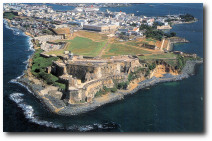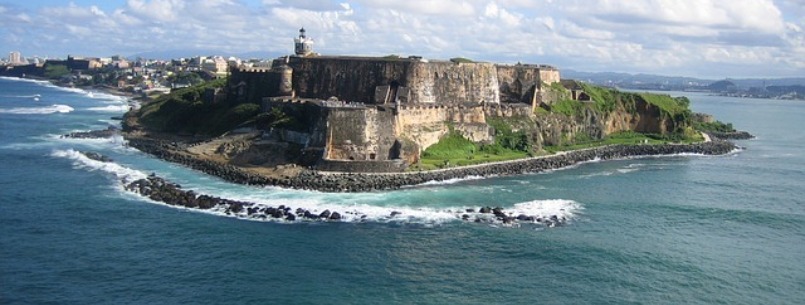Puerto Rico lies like a virgin paradise in the lap of the sea. The Indians called it Borinquen, and Columbus, on reaching its shores in 1493, called it San Juan Bautista. The seaway linking Europe, America and Africa was the envy of all those navigators who sailed past its coastline. Both pirates and sailors from Europe fought over it for treasure. Often attacked by sea, the island built fortifications and bastions which characterize its appearance today. Governed by Spaniards until 1898, it was lost during the Spanish-American war and now the island is part of the United States of America, though its culture and way of life are quite different.
 Puerto Rico’s history is reflected in the island’s personality, in the design of the cities, the shape of its houses and the spirit of its inhabitants. Alongside its deeply marked colonial inheritance is the image of a modern country standing among the most developed regions of America.
Puerto Rico’s history is reflected in the island’s personality, in the design of the cities, the shape of its houses and the spirit of its inhabitants. Alongside its deeply marked colonial inheritance is the image of a modern country standing among the most developed regions of America.
Old San Juan, the old capital founded in 1521, is the heart and center of island activities. Strolling along the streets of Old San Juan one can sense the calm, peaceful rhythm of island living. Leaving Old San Juan one can find a vibrant modern metropolis formed by El Condado, Isla Verde, Santurce, and Hato Rey. Just ahead, Rio Piedras houses the University of Puerto Rico, founded in 1903.
As we penetrate further, in the land of “jibaro”, we reach the countryside and peasant villages that have preserved their personality amid the convulsions and progress. Large plantations of coffee, sugar cane and pineapples grow on fertile valleys. This is the idyllic region that the inhabitants call “the island” and it is truly the soul and quintessence of Puerto Rico. Along a winding road, we can reach the towns of the Central Mountain Range: Utuado, Lares, Jayuya, and Cayey among others.
To the south is La Parguera, a village of magical and mysterious nights known for its phosphorescent waters. Warm and tropical beaches with blue or emerald waters abound on this lovely island: Guanica and Boqueron to the southwest, overlooking the Caribbean; northwest is Anasco, Rincon, and Aguadilla; north is Guajataca and Dorado.
To the east, sheltered by El Yunque Rin Forest, Luquillo Beach is one of the finest and most frequented. Here we are able to go straight from the sunny coast to the green rain forest where more than two hundred species trees grow cared by the Caribbean National Forest of the U.S. National Park System.
Next to the natural paradise, Puerto Rico’s industry has developed in the form of tinning factories. Vieques and Culebra, islands east of Puerto Rico, have some of the most spectacular and secluded beaches in the country, white sands and lush scenery. Ponce, “The Pearl of The South”, the island’s second city is an artistic, cultural and industrial city. Some attractions include the picturesque Parque de Bombas (firehouse) built in 1883, its Cathedral, the Ponce Art Museum, and its 300-year-old ceiba tree.
Handwork
The Puerto Rican peasants have created his own lazy poetical brand of craftwork: hammocks, artificial flowers, and musical instruments. With simple materials, the artist has been able to create the luxury of peace and restfulness.
Folklore
Puerto Rico’s varied folklore has developed from the mixture of old island traditions with Spanish influence. Cockfighting is still a popular sport in Puerto Rico. All in all, Puerto Rico encloses in its 100×35 miles an array of multiple attractions and entertainment to please all desires and whims.
